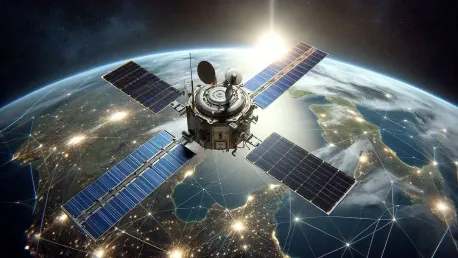Rarely today there is a modern individual that does not own a cellular phone, if not a smartphone – but what about satellite phones? The satellite phones have been around for a while: in 1979 Inmarsat, (an acronym for International Maritime Satellite Organization), enabled the first communication via this kind of terminal, continuing its activity by producing phones for marine vessels communications. The organization counted 28 states in 1976, and was established precisely in order to provide a global satellite communication network.
Another source (Forbes) lists 1965 as the year of the “primary satellite network infrastructure”, and Intelsat as the intergovernmental organization/consortium that established their first satellite in geostationary orbit during that year.
Iridium (the pre-1998 company) was the first satellite phone that offered global coverage through its 77 satellites that communicated via inter-satellite links. The re-established Iridium is now one of the four companies that own satellite phone networks, along Globalstar, Thuraya and ACeS.
How do satellite phones work?
Common mobile phones rely on a network connected via terrestrial cell sites. Satellite phones are able to connect via orbiting satellites, thus being more reliable. Provided the satellites are functioning in the normal parameters, satellite phones offer the same services as regular phones do, having a wider coverage that can extend to the entire globe, or be limited to some of its regions. In order to access this communication network however, the users cannot be indoors, unless they possess special Docking Units.
Another benefit for the satellite phone owners would be that violent weather phenomena do not affect satellite-powered communications since the ground system is bypassed by the technology involved. There are nevertheless some differences depending on what type of satellite network the phone relies on.
Geostationary satellites power satellite phones communications, with certain limitations, such as latitude use or line-of-sight obstacles that can impact proper communications.
The alternative consists of Low Earth Orbit (LEO) satellite technology, which provides worldwide coverage via a network of satellites, avoiding any possible gaps. Globalstar and Iridium networks are both LEO-based.
Another coverage issue is represented by the fact that some countries forbid or limit the possession of satellite phones. In Burma, China, Cuba, India, North Korea and Russia do not allow legal possession and there are assumptions regarding the reason for this. Since intercepting satellite phone traffic requires a more sophisticated technology, communications via these phones are presumably more private.
Choosing the right satellite phone
The phones themselves currently have a smaller size and compete with regular mobile phones in appearance. Nevertheless, these are rugged, terrain phones, as opposed to the almost accessory-like status smartphone for example acquired in the past years.
Satellite phones are mostly being used by professionals who need a reliable phone connection regardless of the weather or geographical position, such as those who work in infrastructure, critical services, and state agencies or in private companies with activities that require independent connectivity no matter the environment conditions.
As we have mentioned above, there are just a few worldwide companies that offer satellite phone services. As their products (phone terminals) are designed for functionality and not so much for style, the options are rather limited.
There are a few available online recommendations concerning the elements to consider when choosing a satellite phone. An instructive article that compares the Globalstar Satellite Phones and the IsatPhone PRO underlines how the size of the phone, the handset cost, and the monthly fee can influence the choice. Depending on how necessary various features are for the phone user, the overall configuration can include more sophisticated data capabilities (communication via text), Wi-Fi, Bluetooth, and GPS-based capabilities.
The Forbes article we have already quoted above clearly states that the only two reliable and effectively global networks are Inmarsat and Iridium. Globalstar ranks third, but is marked as unreliable by this source. Thuraya is not destined for use in North America. Its webpage lists roaming GSM services availability in U.S. via T-Mobile, Alltel and AT&T Mobility.
You may check here a comparison chart and buyer’s guide, completed with 11 FAQs and a very useful approach of the Internet access issue on satellite phones. In order to benefit from Internet accessibility, satellite phones need a portable BGAN or a Hub terminal. Another way of accessing the Internet involves the use of a smartphone when the satellite phone itself features a Wi-Fi capability. Each accessory adds to the satellite phone base price, and they are rather specialized accessories: BGAN portable (for stationary use), BGAN vehicular (for on-the-move usage, in association with vehicle-mounted antennas), VSAT mobile dishes (more powerful, coming with portable VSAT terminals).
Another review of satellite phone accessories that allows users to transmit two-way text messages and have global Internet coverage mentions Iridium Go, Inmarsat IsatHub and Globalstar Sat-Fi and their test results – pay attention to the devices’ costs and to their compatibility with any possible apps you might want to use.
Alternative options for satellite communications
There are companies that offer satellite phones for rent – this way the interested persons can pay to use such devices only for the time they actually need them, without committing to a full contract with the satellite communications provider of choice. The same source provides info on how some countries (China, Indi and Myanmar) require a permit in order to legally use such phones on their territory.
A 2015 ZDNet article analyses how an Android smartphone or an iPhone can be transformed into a satellite phone by using a Thuraya SatSleeve. However, note that the dedicated webpage mentions only “Europe, Africa, Asia and Australia” as the covered areas when it comes to access to this smartphone “satellite mode”. When outside the Thuraya satellite footprint area, their equipment is unusable. However this accessory does not come cheap nor abundant (Amazon has it for sale at $542.50, only a few pieces in stock for each type). Basically this alternative suits the world travelers that would like the commodity of a satellite phone without investing in a dedicated handset in an area Thuraya offers coverage.
In conclusion, owning a satellite phone is not cheap and it also presumes an effort in getting very well informed beforehand. Available local dealers, compatibility when it comes to the location-coverage equation, making sure you have all the necessary accessories and learning to deal with this rugged devices simpler interfaces are all necessary steps. Yet, depending on your profession or hobbies, they might all be worth it because they provide (almost) global connectivity and geographical and weather independence. With a satellite phone, your messages bypass the local cell towers and the local climate events, heading straight for the satellites orbiting around the globe and to the message recipients.









